Mattingly J.D., Heiser W.H., Pratt D.T. Aircraft Engine Design
Подождите немного. Документ загружается.

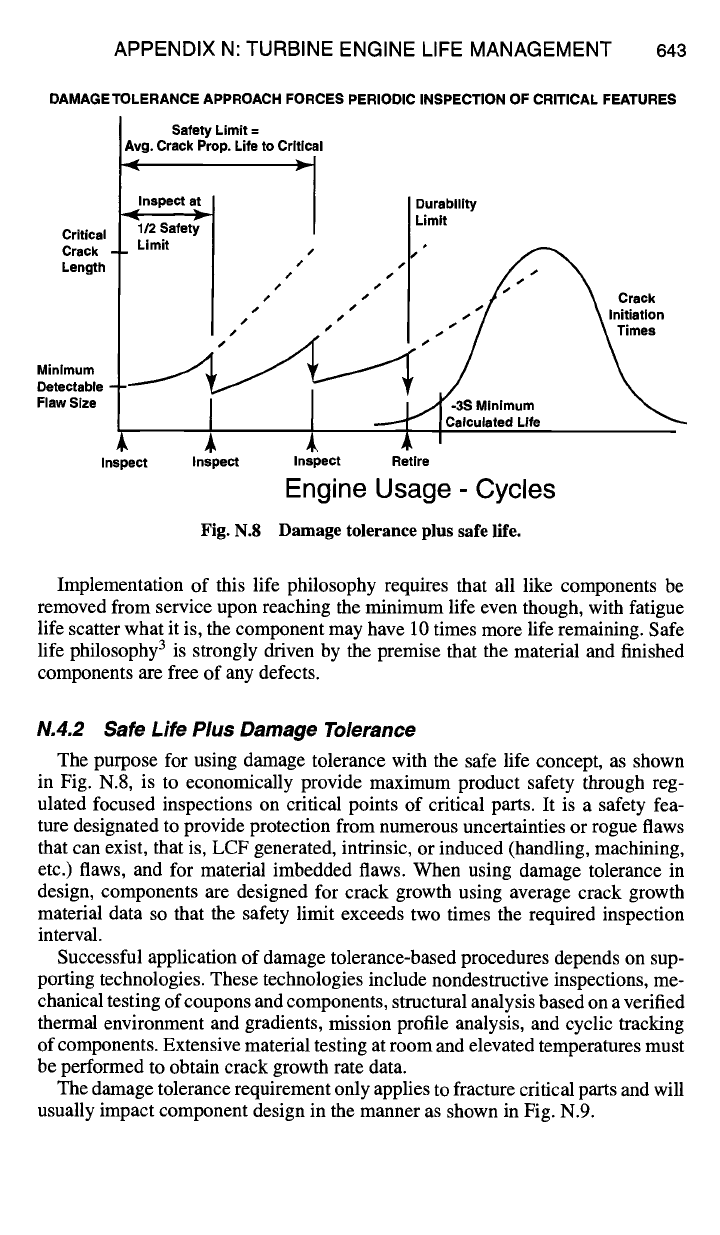
APPENDIX N: TURBINE ENGINE LIFE MANAGEMENT 643
DAMAGE TOLERANCE APPROACH FORCES PERIODIC INSPECTION OF CRITICAL FEATURES
Safety Limit
=
I Avg. Crack Prop.
Life to Critical
Inspect at Durability
~--
Limit
-"1/2
Safety
Cr tica I . ,
Crack Jr- Limit
,,
Length
l ,/ , s ~s
/ " ,' p/s" \
Crack
/ / 4 ..
l / ,, ,. "/ \
Initiation
/ s / s s s s / \
Times
in'm" -/ \
.~tectable
Inspect Inspect Inspect Retire
Engine Usage - Cycles
Fig. N.8 Damage tolerance plus safe life.
Miniml
Detectable
Flaw Size
Implementation of this life philosophy requires that all like components be
removed from service upon reaching the minimum life even though, with fatigue
life scatter what it is, the component may have 10 times more life remaining. Safe
life philosophy 3 is strongly driven by the premise that the material and finished
components are free of any defects.
N.4.2 Safe Life Plus Damage Tolerance
The purpose for using damage tolerance with the safe life concept, as shown
in Fig. N.8, is to economically provide maximum product safety through reg-
ulated focused inspections on critical points of critical parts. It is a safety fea-
ture designated to provide protection from numerous uncertainties or rogue flaws
that can exist, that is, LCF generated, intrinsic, or induced (handling, machining,
etc.) flaws, and for material imbedded flaws. When using damage tolerance in
design, components are designed for crack growth using average crack growth
material data so that the safety limit exceeds two times the required inspection
interval.
Successful application of damage tolerance-based procedures depends on sup-
porting technologies. These technologies include nondestructive inspections, me-
chanical testing of coupons and components, structural analysis based on a verified
thermal environment and gradients, mission profile analysis, and cyclic tracking
of components. Extensive material testing at room and elevated temperatures must
be performed to obtain crack growth rate data.
The damage tolerance requirement only applies to fracture critical parts and will
usually impact component design in the manner as shown in Fig. N.9.
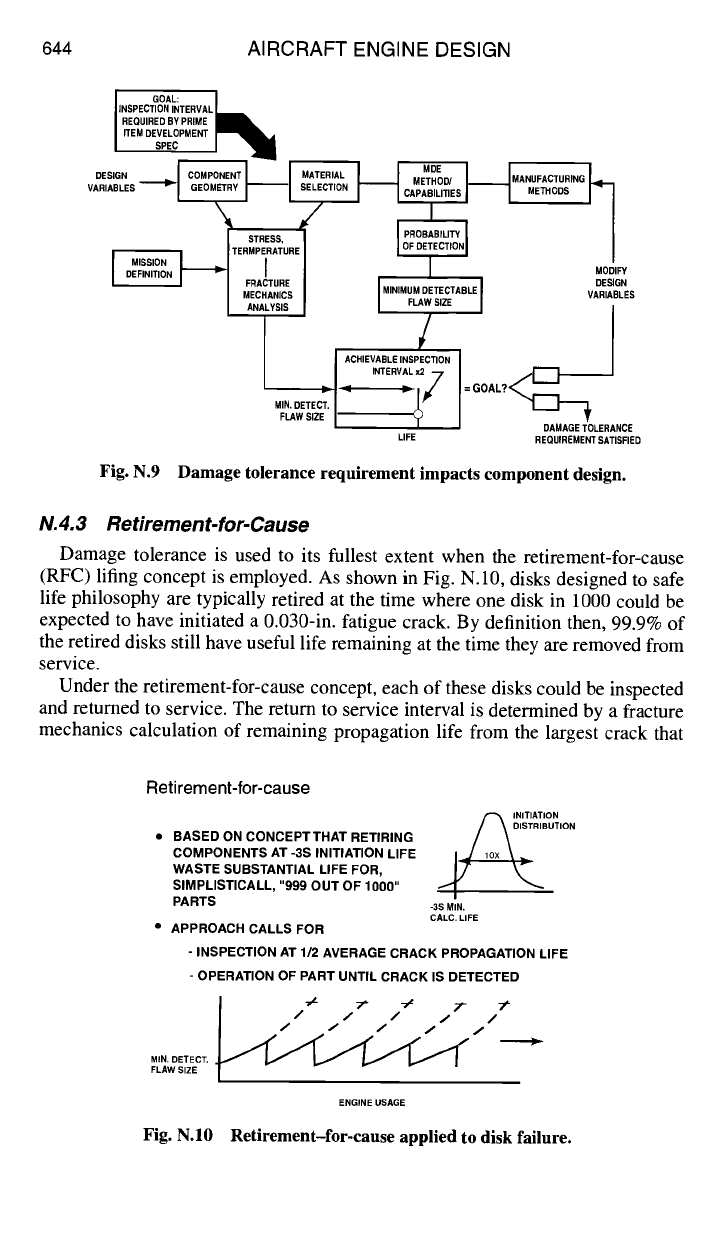
644 AIRCRAFT ENGINE DESIGN
GOAL:
INSPECTION INTERVAL
REQUIRED BY PRIME
ITEM DEVELOPMENT
I SPEC
DESIGN
VARIABLES
Fig. N.9
/
ACHIEVABLE INSPECTION
INTERVAL x2 <~
MIN. DETECT.
FLAW SIZE
LIFE
MODIFY
DESIGN
VARIABLES
+
DAMAGE TOLERANCE
REQUIREMENT SATISFIED
Damage tolerance requirement impacts component design.
N.4.3 Retirement-for-Cause
Damage tolerance is used to its fullest extent when the retirement-for-cause
(RFC) lifing concept is employed. As shown in Fig. N.10, disks designed to safe
life philosophy are typically retired at the time where one disk in 1000 could be
expected to have initiated a 0.030-in. fatigue crack. By definition then, 99.9% of
the retired disks still have useful life remaining at the time they are removed from
service.
Under the retirement-for-cause concept, each of these disks could be inspected
and returned to service. The return to service interval is determined by a fracture
mechanics calculation of remaining propagation life from the largest crack that
Retirement-for-cause
• BASED ON CONCEPTTHAT RETIRING
COMPONENTS AT -3S INITIATION LIFE
WASTE SUBSTANTIAL LIFE FOR,
SIMPLISTICALL, "999 OUT OF 1000"
PARTS
• APPROACH CALLS FOR
INITIATION
/UTIO N
-3S MIN.
CALC, LIFE
- INSPECTION AT 1/2 AVERAGE CRACK PROPAGATION LIFE
-
OPERATION OF PART UNTIL CRACK IS DETECTED
"/- 7" -/ 7"- 7'-
• / / ./ ./ /
/ / / f ./
j" .,( j, j /
>
MIN. DETECT. / L~'~ L,.,.,."' f I" ~'~.,~'~
FLAW SIZE
ENGINE USAGE
Fig. N.10 Retirement-for-cause applied to disk failure.

APPENDIX N: TURBINE ENGINE LIFE MANAGEMENT 645
could have been missed during inspection. This procedure could be repeated until
the disk has incurred measurable damage, at which time it is retired for a cause.
Retirement-for-cause, then, is a methodology under which an engine disk would be
retired from service when it had incurred quantifiable damage, rather than because
an analytically determined minimum design life had been exceeded. Its purpose
is not to extend the life of the rotor disk, but to use safely the full life capacity
inherent in each part. In many cases, the decision as to whether or not RFC can
be applied to a component will be predicated upon the ability of available NDE
approaches to detect the initial flaw with sufficient sensitivity and reliability.
N.5 Inspection and PODs
The concept of damage tolerance is strongly based on the ability of fracture
mechanics analysis to predict crack growth life with reasonable accuracy coupled
with the capability of NDE to reliably find defects. The capability of NDE to
reliably find defects is quantified through test data to determine the flaw size
defined by a POD of 90% with a CL of 95%. The generation of these data is
accomplished for each NDE technique (dye penetrant, eddy-current, ultrasonic,
etc.). The technique for generating surface cracks in specimens, with and without
original cracks, to be inspected to obtain data is shown in Fig. N. 11. The specimens,
with and without cracks, are then inspected by trained inspectors, and the hit/missed
data are gathered. The estimated POD and CL are determined statistically and
plotted, as shown in Figs. N.12 and N.13. Comparison of mean crack detection
capabilities of several NDE methods for Titanium 6A1-4V materials is shown
in
Fig. N.14.
N.5.1 Fluorescent Penetrant Inspection
Liquid penetrant inspection is used to detect small discontinuities that cannot be
easily found during simple visual inspection. The method depends on the ability of
a highly penetrating liquid to seep, through capillary action, into any discontinuity
in the material to which it is applied. It can only be used to detect surface defects
and subsurface defects that are open to the surface. There are six critical steps in
the penetrant inspection of a part:
1. EDM Starter Notch
2. Fatigue In 3-Point Bend
3. Grind Off Starter Notch
4. Grow Crack To Desired Size
Fig. N.11 Fatigue crack generation.
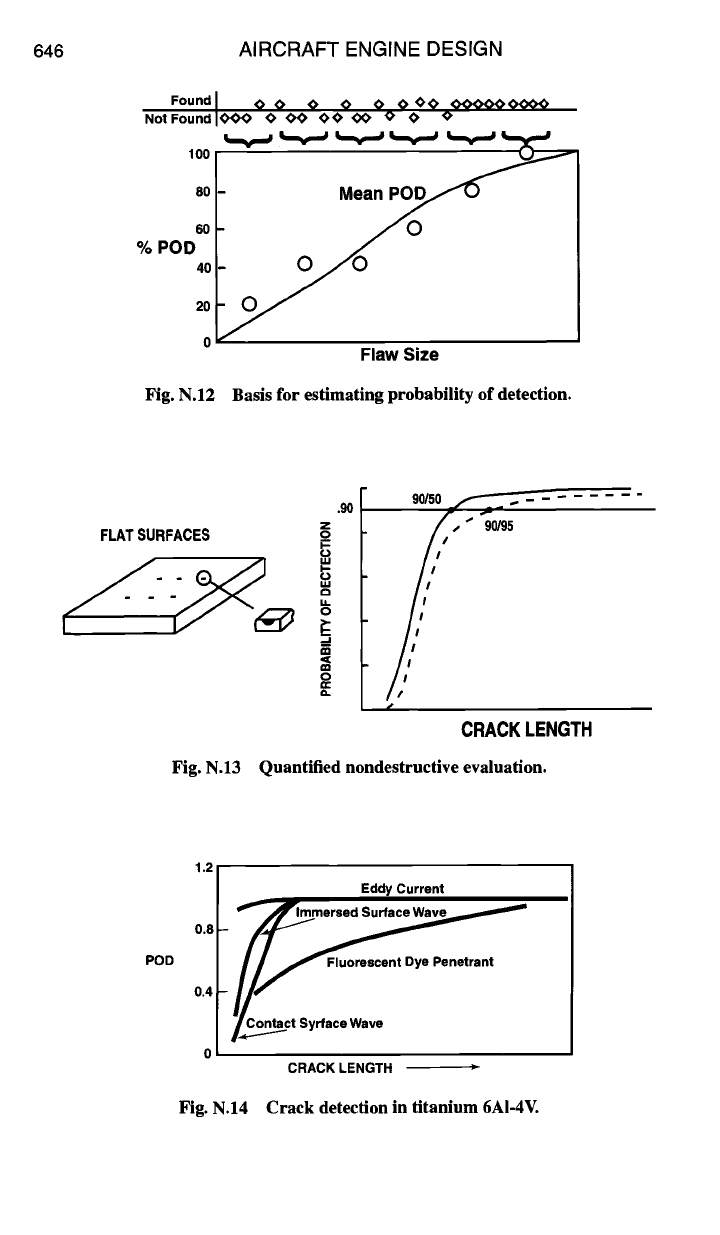
646 AIRCRAFT ENGINE DESIGN
Foundl o o o o o o o<> ooooooooo
Not FoundIOOO 0 O0 O0 O0 o 0 o
100
80
60
%
POD
40
20
Flaw Size
Fig. N.12 Basis for estimating probability of detection.
FLAT SURFACES
.9O
z
o
p-
p-
ro
O
90/50 ~ ......
S-
s
s 90/95
l'
!
¢.
CRACK LENGTH
Fig. N.13 Quantified nondestructive evaluation.
1.2
0.8
POD
0.4
Eddy Current
/f Fluorescent Dye Penetrant
/.~Co.~ct Syrface Wave
CRACK LENGTH
Fig. N.14 Crack detection in titanium 6AI-4V.
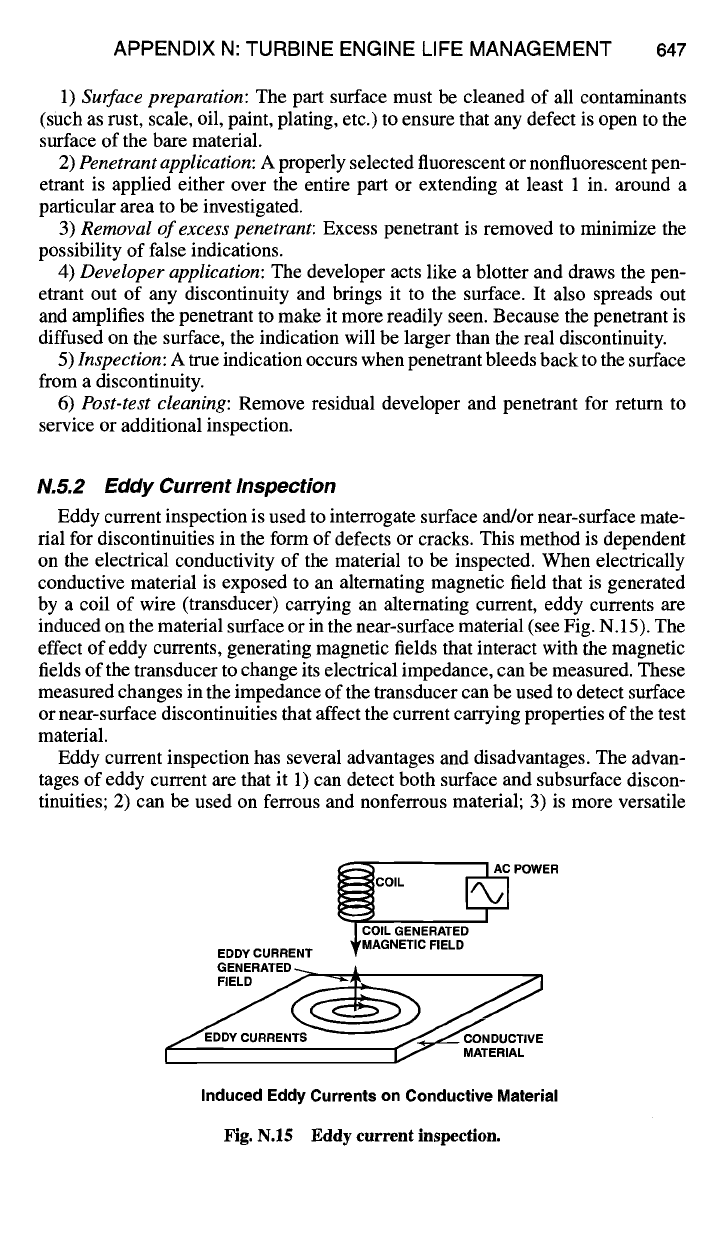
APPENDIX N: TURBINE ENGINE LIFE MANAGEMENT 647
1)
Surface preparation:
The part surface must be cleaned of all contaminants
(such as rust, scale, oil, paint, plating, etc.) to ensure that any defect is open to the
surface of the bare material.
2)
Penetrant application:
A properly selected fluorescent or nonfluorescent pen-
etrant is applied either over the entire part or extending at least 1 in. around a
particular area to be investigated.
3)
Removal of excess penetrant:
Excess penetrant is removed to minimize the
possibility of false indications.
4)
Developer application:
The developer acts like a blotter and draws the pen-
etrant out of any discontinuity and brings it to the surface. It also spreads out
and amplifies the penetrant to make it more readily seen. Because the penetrant is
diffused on the surface, the indication will be larger than the real discontinuity.
5)
Inspection: A
true indication occurs when penetrant bleeds back to the surface
from a discontinuity.
6)
Post-test cleaning:
Remove residual developer and penetrant for return to
service or additional inspection.
N.5.2 Eddy Current Inspection
Eddy current inspection is used to interrogate surface and/or near-surface mate-
rial for discontinuities in the form of defects or cracks. This method is dependent
on the electrical conductivity of the material to be inspected. When electrically
conductive material is exposed to an alternating magnetic field that is generated
by a coil of wire (transducer) carrying an alternating current, eddy currents are
induced on the material surface or in the near-surface material (see Fig. N. 15). The
effect of eddy currents, generating magnetic fields that interact with the magnetic
fields of the transducer to change its electrical impedance, can be measured. These
measured changes in the impedance of the transducer can be used to detect surface
or near-surface discontinuities that affect the current carrying properties of the test
material.
Eddy current inspection has several advantages and disadvantages. The advan-
tages of eddy current are that it 1) can detect both surface and subsurface discon-
tinuities; 2) can be used on ferrous and nonferrous material; 3) is more versatile
~ POWER
COIL
COIL GENERATED
EDDY CURRENT MAGNETIC FIELD
GENERATED -....~ A
Induced Eddy Currents on Conductive Material
Fig. N.15 Eddy current inspection.

648 AIRCRAFT ENGINE DESIGN
than fluorescent penetrant inspection methods; 4) has adjustable sensitivity, and
5) is portable.
The disadvantages are as follows: 1) the applications are limited to electrically
conductive material, 2) they require reference standards and specific operator train-
ing, and 3) there is difficulty in some cases in interpreting results.
Very little part preparation is needed for eddy current inspection. The surface of
the area to be inspected may need to be cleaned or otherwise exposed so that the
eddy current probe has adequate access. The inspection is accomplished in real
time, where the probe-sensed variations in impedance are displayed on a meter or
computer screen. This allows the inspector to reinspect to confirm the presence of
an indication prior to further interpretation.
Eddy current inspection has become a highly reliable method for detecting
surface and near-surface defects, and has been used to enhance other surface
inspection methods (visual and fluorescent penetrants) in evaluating the presence
of defects, or for inspecting areas where visual observation is impracticable. To
maintain high reliability in detecting defects, particular care must be taken in the
setup of the eddy current system and in the interpretation of displayed signals. It
is therefore necessary to ensure that the inspector is properly trained to operate an
eddy current system.
N.5.3 Ultrasonic Inspection
Ultrasonic inspection applications include 1) thickness checks, 2) billet in-
spection for internal defects, 3) forging inspection for internal defects, 4) weld
examination, 5) surface defects on blades and engine-run hardware, and 6) com-
posite inspection for delaminations and porosity.
The basis for ultrasonic inspection is the detection of reflected or absorption of
acoustic energy. It records amplitude and distance to echo and can be used to find
surface and subsurface defects.
High-frequency mechanical vibrations are introduced to the part through a cou-
pling medium, and energy reflected is detected and displayed on a computer screen.
Figure N.16 shows ultrasonic signal displays using unfiltered signals as well as
the type of signal that is caused by the use of coarse grain material.
N.6 Engine Structural Development Plan
A typical layout of a structural development plan required by the U.S. Air Force
Engine Structural Integrity Program (ENSIP 4) that is included in a military RFP
is shown in Fig. N.17. ENSIP is an organized and disciplined approach to the
structural design, analysis, development, production, and life management of gas
turbine engines. The goal is to ensure engine structural safety, increase service
readiness, and reduce life cycle costs through reducing the occurrence of structural
durability problems during service operations. The plan would require the type of
detail as stated in the following subsections.
N.& 1 TASK I--Design Information
N.6.1. I Master plan.
The contractor shall prepare a time-phased plan for
the accomplishment of the required tasks.
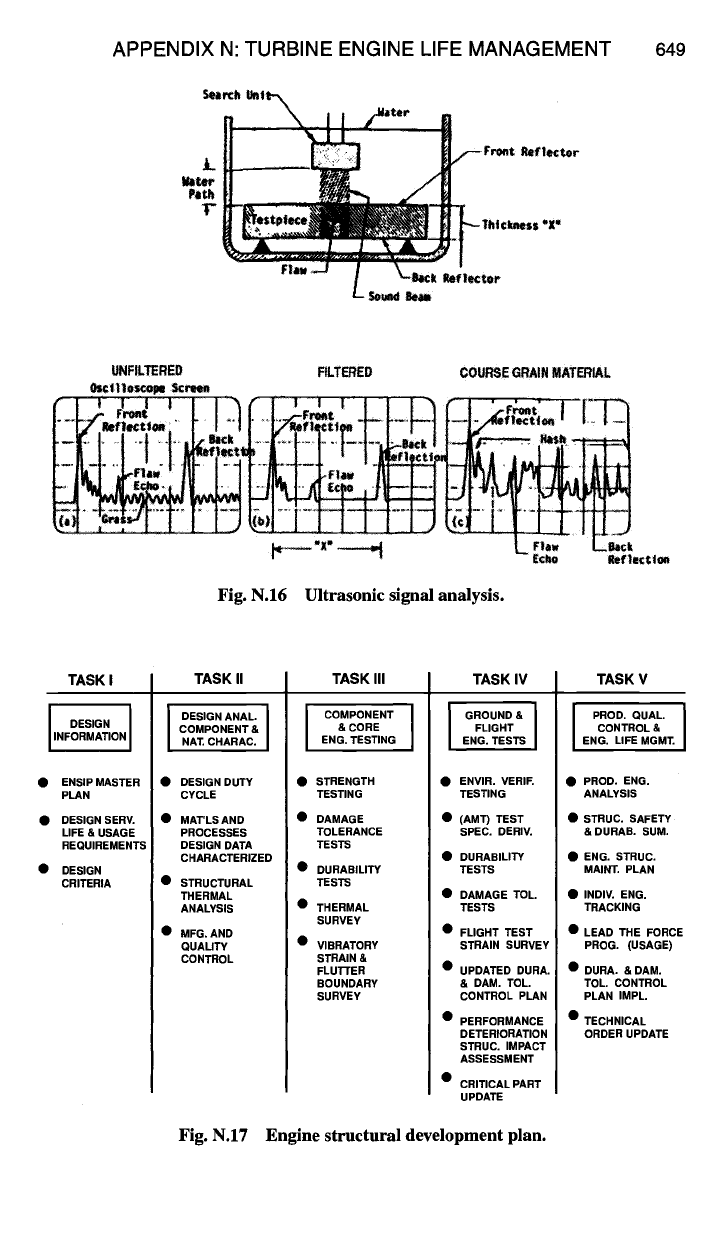
APPENDIX N: TURBINE ENGINE LIFE MANAGEMENT
Sea
649
i_
~t~
hth
T"
UNFILTERED FILTERED COURSE GRAIN MATERIAL
Oz¢lllo~ Scre~
|= ]- | - | FPont
I )Rt fl
ti
e¢¢fon
Fig. N.16 Ultrasonic signal analysis.
TASK I
DESIGN I
NFORMATONI ]
• ENSIP MASTER •
PLAN
• DESIGN SERV, •
LIFE & USAGE
REQUIREMENTS
• DESIGN
CRITERIA •
TASK II
DESIGN ANAL. I
COMPONENT&
NAT. CHARAC.
DESIGN DUTY
CYCLE
MAT'LS AND
PROCESSES
DESIGN DATA
CHARACTERIZED
STRUCTURAL
THERMAL
ANALYSIS
MFG, AND
QUALIFY
CONTROL
TASK III
I COMPONENT
& CORE
ENG, TESTING
• STRENGTH
TESTING
• DAMAGE
TOLERANCE
TESTS
• DURABILITY
TESTS
• THERMAL
SURVEY
• VIBRATORY
STRAIN &
FLUTFER
BOUNDARY
SURVEY
TASK IV
GROUND &
FLIGHT
ENG. TESTS
• ENVIR. VERIF.
TESTING
• (AMT) TEST
SPEC. DERIV.
• DURABILITY
TESTS
• DAMAGE TOL.
TESTS
• FLIGHT TEST
STRAIN SURVEY
• UPDATED DURA.
& DAM. TOL,
CONTROL PLAN
• PERFORMANCE
DETERIORATION
STRUC. IMPACT
ASSESSMENT
• CRITICAL PART
UPDATE
Fig. N.17 Engine structural development plan.
TASK V
I PROD. QUAL. I
CONTROL&
ENG, LIFE MGM~
• PROD. ENG.
ANALYSIS
• STRUC. SAFETY
& DURAB. SUM.
Q ENG. STRUC.
MAINT. PLAN
• INDI~ ENG.
TRACKING
• LEADTHE FORCE
PROG. (USAGE)
• DURA. & DAM.
TOE CONTROL
PLAN IMPL.
• TECHNICAL
ORDER UPDATE
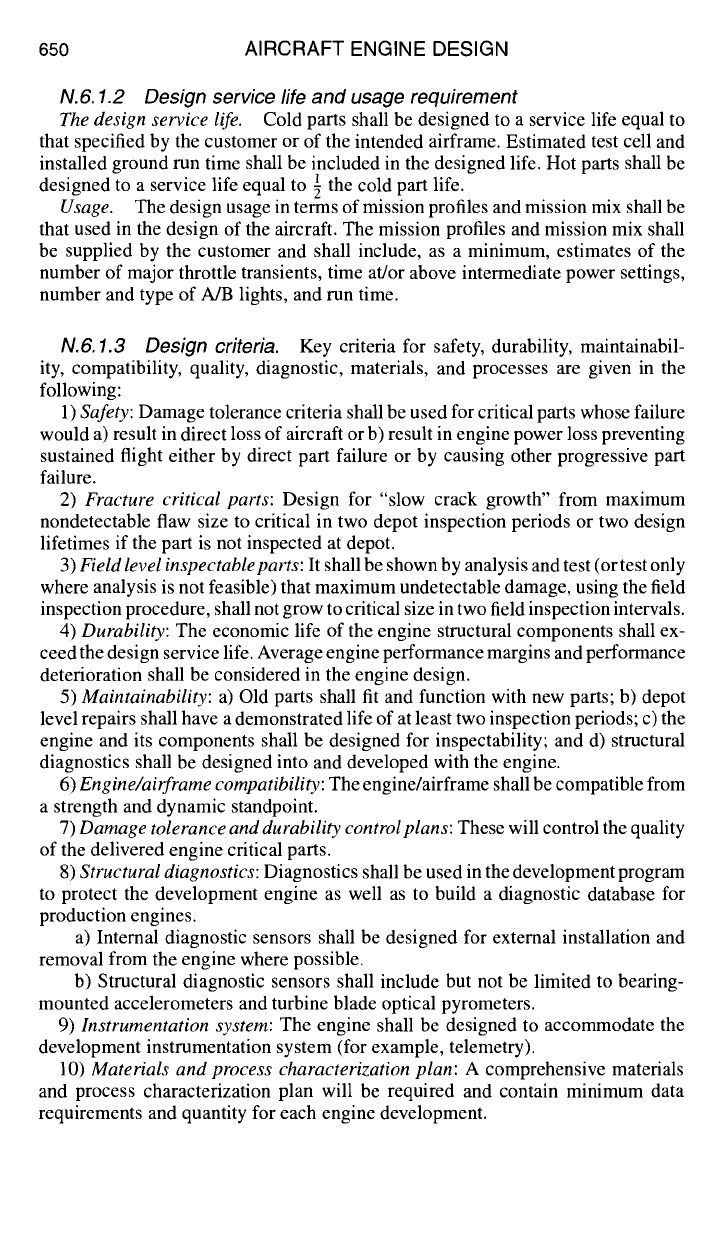
650 AIRCRAFT ENGINE DESIGN
N.6.1.2 Design service fife and usage requirement
The design service life. Cold parts shall be designed to a service life equal to
that specified by the customer or of the intended airframe. Estimated test cell and
installed ground run time shall be included in the designed life. Hot parts shall be
the cold part life. designed to a service life equal to
Usage. The design usage in terms of mission profiles and mission mix shall be
that used in the design of the aircraft. The mission profiles and mission mix shall
be supplied by the customer and shall include, as a minimum, estimates of the
number of major throttle transients, time at/or above intermediate power settings,
number and type of A/B lights, and run time.
N.6. 1.3 Design criteria.
Key criteria for safety, durability, maintainabil-
ity, compatibility, quality, diagnostic, materials, and processes are given in the
following:
1) Safety: Damage tolerance criteria shall be used for critical parts whose failure
would a) result in direct loss of aircraft or b) result in engine power loss preventing
sustained flight either by direct part failure or by causing other progressive part
failure.
2) Fracture critical parts: Design for "slow crack growth" from maximum
nondetectable flaw size to critical in two depot inspection periods or two design
lifetimes if the part is not inspected at depot.
3) Field level inspectableparts: It shall be shown by analysis and test (or test only
where analysis is not feasible) that maximum undetectable damage, using the field
inspection procedure, shall not grow to critical size in two field inspection intervals.
4) Durability: The economic life of the engine structural components shall ex-
ceed the design service life. Average engine performance margins and performance
deterioration shall be considered in the engine design.
5) Maintainability: a) Old parts shall fit and function with new parts; b) depot
level repairs shall have a demonstrated life of at least two inspection periods; c) the
engine and its components shall be designed for inspectability; and d) structural
diagnostics shall be designed into and developed with the engine.
6) Engine~airframe compatibility: The engine/airframe shall be compatible from
a strength and dynamic standpoint.
7) Damage tolerance and durability controlplans: These will control the quality
of the delivered engine critical parts.
8) Structural diagnostics: Diagnostics shall be used in the development program
to protect the development engine as well as to build a diagnostic database for
production engines.
a) Internal diagnostic sensors shall be designed for external installation and
removal from the engine where possible.
b) Structural diagnostic sensors shall include but not be limited to bearing-
mounted accelerometers and turbine blade optical pyrometers.
9) Instrumentation system: The engine shall be designed to accommodate the
development instrumentation system (for example, telemetry).
10) Materials and process characterization plan: A comprehensive materials
and process characterization plan will be required and contain minimum data
requirements and quantity for each engine development.
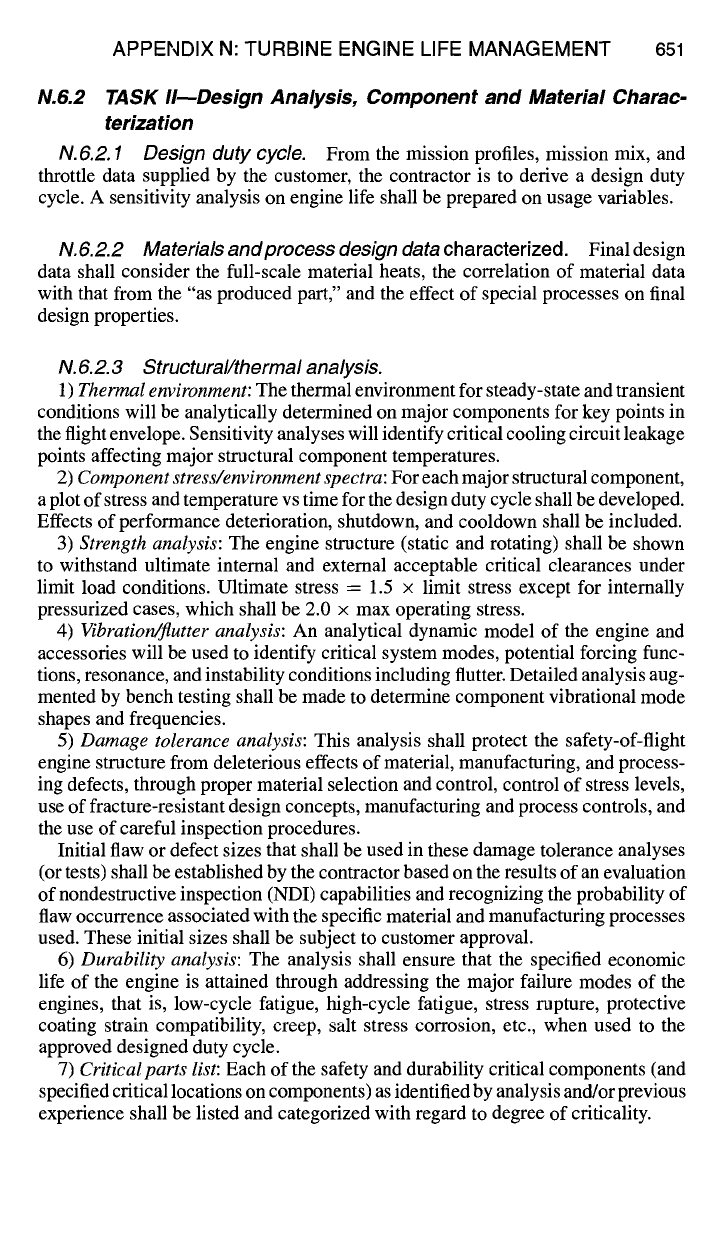
APPENDIX N: TURBINE ENGINE LIFE MANAGEMENT 651
N.6.2 TASK II--Design Analysis, Component and Material Charac-
terization
N.6.2. I Design duty cycle.
From the mission profiles, mission mix, and
throttle data supplied by the customer, the contractor is to derive a design duty
cycle. A sensitivity analysis on engine life shall be prepared on usage variables.
IV.6.2.2 Materials and process design data
characterized. Final design
data shall consider the full-scale material heats, the correlation of material data
with that from the "as produced part," and the effect of special processes on final
design properties.
N.6.2.3 Structural~thermal analysis.
1) Thermal environment:
The thermal environment for steady-state and transient
conditions will be analytically determined on major components for key points in
the flight envelope. Sensitivity analyses will identify critical cooling circuit leakage
points affecting major structural component temperatures.
2)
Component stress~environment spectra:
For each major structural component,
a plot of stress and temperature vs time for the design duty cycle shall be developed.
Effects of performance deterioration, shutdown, and cooldown shall be included.
3)
Strength analysis:
The engine structure (static and rotating) shall be shown
to withstand ultimate internal and external acceptable critical clearances under
limit load conditions. Ultimate stress = 1.5 × limit stress except for intemally
pressurized cases, which shall be 2.0 × max operating stress.
4)
Vibration~flutter analysis:
An analytical dynamic model of the engine and
accessories will be used to identify critical system modes, potential forcing func-
tions, resonance, and instability conditions including flutter. Detailed analysis aug-
mented by bench testing shall be made to determine component vibrational mode
shapes and frequencies.
5)
Damage tolerance analysis:
This analysis shall protect the safety-of-flight
engine structure from deleterious effects of material, manufacturing, and process-
ing defects, through proper material selection and control, control of stress levels,
use of fracture-resistant design concepts, manufacturing and process controls, and
the use of careful inspection procedures.
Initial flaw or defect sizes that shall be used in these damage tolerance analyses
(or tests) shall be established by the contractor based on the results of an evaluation
of nondestructive inspection (NDI) capabilities and recognizing the probability of
flaw occurrence associated with the specific material and manufacturing processes
used. These initial sizes shall be subject to customer approval.
6)
Durability analysis:
The analysis shall ensure that the specified economic
life of the engine is attained through addressing the major failure modes of the
engines, that is, low-cycle fatigue, high-cycle fatigue, stress rupture, protective
coating strain compatibility, creep, salt stress corrosion, etc., when used to the
approved designed duty cycle.
7)
Critical parts list:
Each of the safety and durability critical components (and
specified critical locations on components) as identified by analysis and/or previous
experience shall be listed and categorized with regard to degree of criticality.
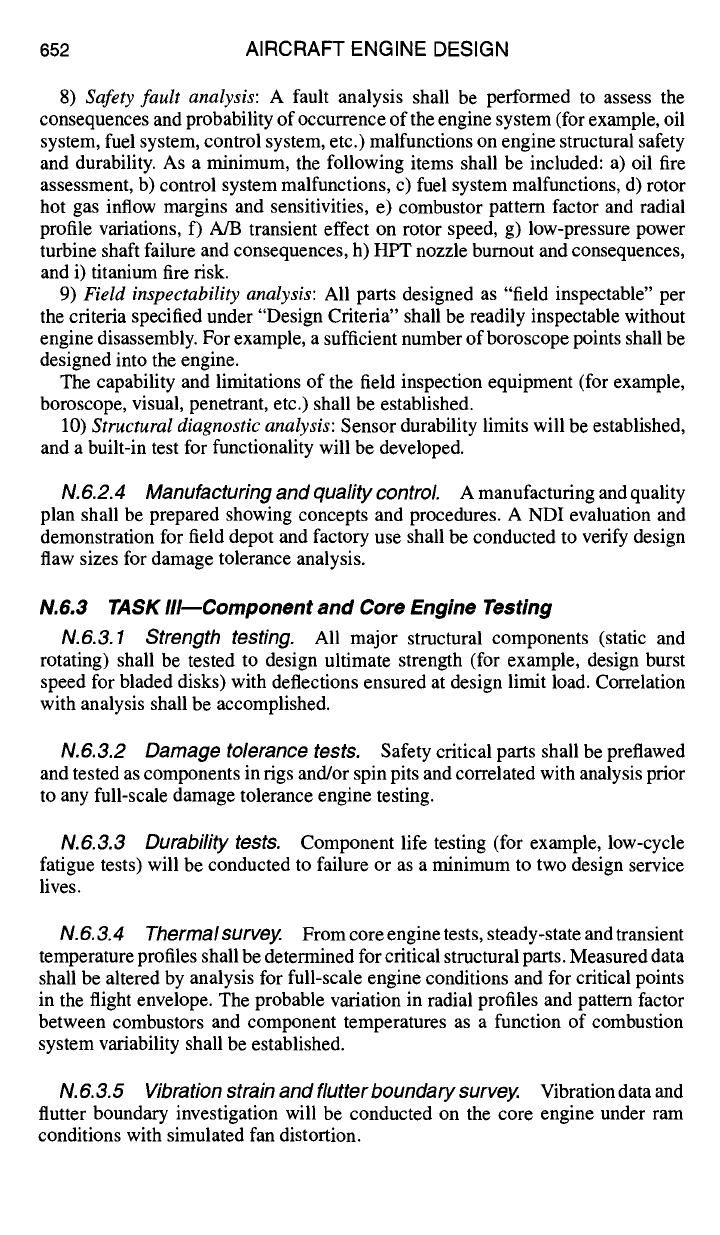
652 AIRCRAFT ENGINE DESIGN
8)
Safety fault analysis:
A fault analysis shall be performed to assess the
consequences and probability of occurrence of the engine system (for example, oil
system, fuel system, control system, etc.) malfunctions on engine structural safety
and durability. As a minimum, the following items shall be included: a) oil fire
assessment, b) control system malfunctions, c) fuel system malfunctions, d) rotor
hot gas inflow margins and sensitivities, e) combustor pattern factor and radial
profile variations, f) A/B transient effect on rotor speed, g) low-pressure power
turbine shaft failure and consequences, h) HPT nozzle burnout and consequences,
and i) titanium fire risk.
9)
Field inspectability analysis:
All parts designed as "field inspectable" per
the criteria specified under "Design Criteria" shall be readily inspectable without
engine disassembly. For example, a sufficient number of boroscope points shall be
designed into the engine.
The capability and limitations of the field inspection equipment (for example,
boroscope, visual, penetrant, etc.) shall be established.
10)
Structural diagnostic analysis:
Sensor durability limits will be established,
and a built-in test for functionality will be developed.
N.6.2.4 Manufacturing and quafity control A manufacturing and quality
plan shall be prepared showing concepts and procedures. A NDI evaluation and
demonstration for field depot and factory use shall be conducted to verify design
flaw sizes for damage tolerance analysis.
N.6.3 TASK IIImComponent and Core Engine Testing
N.6.3.1 Strength testing. All major structural components (static and
rotating) shall be tested to design ultimate strength (for example, design burst
speed for bladed disks) with deflections ensured at design limit load. Correlation
with analysis shall be accomplished.
N.6.3.2 Damage tolerance tests.
Safety critical parts shall be preflawed
and tested as components in rigs and/or spin pits and correlated with analysis prior
to any full-scale damage tolerance engine testing.
N.6.3.3 Durability tests.
Component life testing (for example, low-cycle
fatigue tests) will be conducted to failure or as a minimum to two design service
lives.
IV.6.3.4 Thermal survey. From core engine tests, steady-state and transient
temperature profiles shall be determined for critical structural parts. Measured data
shall be altered by analysis for full-scale engine conditions and for critical points
in the flight envelope. The probable variation in radial profiles and pattern factor
between combustors and component temperatures as a function of combustion
system variability shall be established.
N. 6. 3.5 Vibration strain and flutter boundary survey. Vibration data and
flutter boundary investigation will be conducted on the core engine under ram
conditions with simulated fan distortion.
